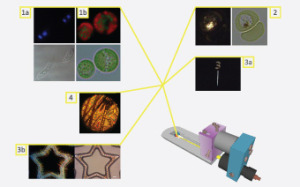Bright-field optical microscope converters, enhance performance

Figure legend – Images obtained using the Oxford device:
Epi-fluorescent technique.
- 1a – an image of Leishmania parasite labeled with DNA-staining blue fluorophore DAPI as seen with the Oxford device without any filters (top) and the same cells seen with a regular bright field microscope (bottom).
- 1b – red chlorophyll fluorescence of a photosynthetic green alga (top) detected with a single emission filter, and bright field image of the same sample (bottom).
Back Scattering Dark Field technique.
- 2 – a bright-field image of a healthy and a malaria organism-infected human erythrocyte as seen with a regular light microscope (right) and a Back Scattering Dark Field image of the same cells with the Oxford device (left).
Surface Reflection technique of various surfaces.
- 3a – a calibration scale on the surface of a special non-transparent graticule. Bright-field microscopy of such surfaces is otherwise impossible.
- 3b – a photo-lithography patterned surface of a transparernt cover slip as seen with a bright-field microscope (right) and with the Oxford device (left).
Interference Reflection technique.
- 4 – uneven varying thickness of a marker-drawn stripe on a glass surface seen as typical interference iridescent patches.
Expansion of light microscope capabilities
Oxford researchers in the Physics department have developed miniature devices for bright-field light microscopes that fit into the slot reserved for DIC objective prisms (also known as the DIC slot). The Oxford devices would very simply and inexpensively convert existing light microscopes with DIC slots into instruments capable of additional applications.
Only one modular device is needed to add these features to a standard microscope. It is also possible to develop individual devices for each technique.
Epi-fluorescence
Epi-fluorescence is a well-established and widely used technique, which has numerous life science and medical applications. It requires relatively expensive kit including a special light source, an epi-illuminator and a set of filters. Using the Oxford epi-fluorescence module, researchers can easily detect fluorescent objects (eg. naturally fluorescent and fluorophore-labelled micro-organisms) using a filter-free setup or just a single emission filter.
Backscattering dark field
Backscattering dark field microscopy is an emerging field and is useful for detection of nanometre-sized objects below the diffraction limit, which makes it highly sought after in the nanotechnology sector. To date, research and development in this field has been limited as backscattering microscopes are not commercially available and researchers need to build them themselves. The instruments are bulky and expensive as a result. Using the Oxford dark-field module, researchers are able to clearly view small objects of sub-micrometre size, in particular 50-100 nm gold particles.
Surface reflection
Surface reflection microscopes are widely used in material science and the semiconductor industry to study surface features of various specimens. They require special configuration of illuminating paths and cannot work without expensive special objectives. Used in surface-reflection mode, the Oxford device allows the result of photolithography or other surface modifying methods to be directly visualised.
Interference reflection
Interference reflection microscopy allows the monitoring of the thickness and quality of thin films. Such microscopes usually require additional optical elements like polarizing prisms and special objectives. With the Oxford device researchers can successfully monitor lipid bilayer formation, and estimate how evenly a thin layer of material has been deposited on a surface of interest.
about this technology

